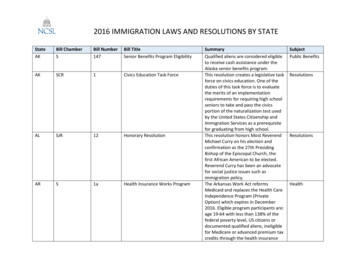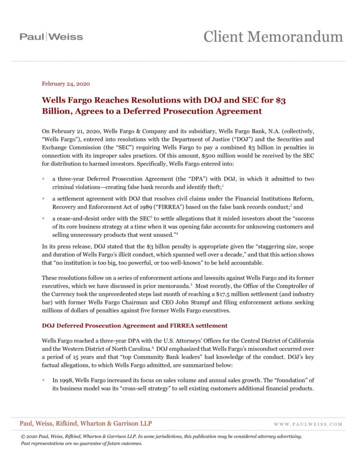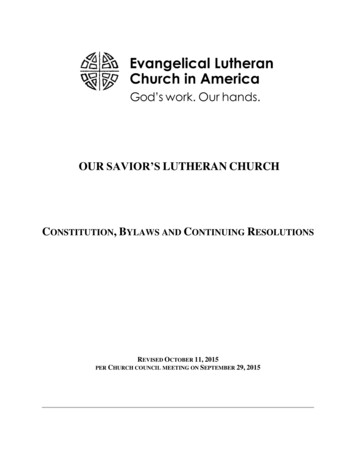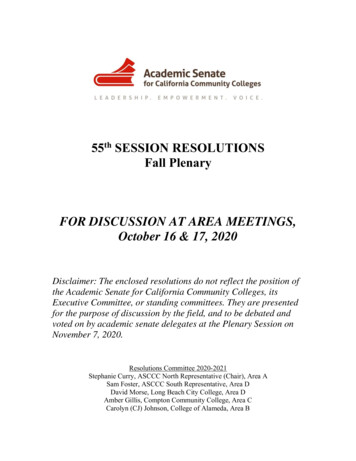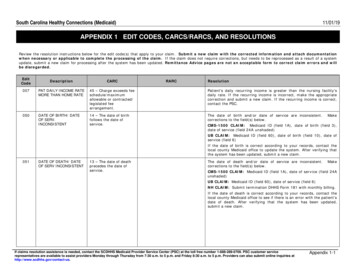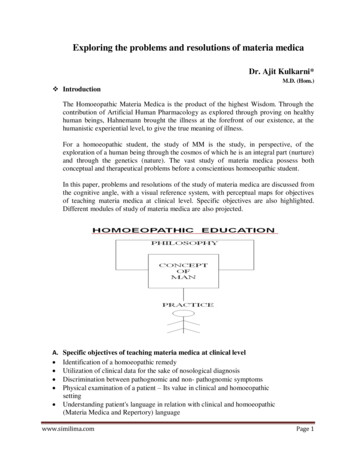
Transcription
Exploring the problems and resolutions of materia medicaDr. Ajit Kulkarni*M.D. (Hom.) IntroductionThe Homoeopathic Materia Medica is the product of the highest Wisdom. Through thecontribution of Artificial Human Pharmacology as explored through proving on healthyhuman beings, Hahnemann brought the illness at the forefront of our existence, at thehumanistic experiential level, to give the true meaning of illness.For a homoeopathic student, the study of MM is the study, in perspective, of theexploration of a human being through the cosmos of which he is an integral part (nurture)and through the genetics (nature). The vast study of materia medica possess bothconceptual and therapeutical problems before a conscientious homoeopathic student.In this paper, problems and resolutions of the study of materia medica are discussed fromthe cognitive angle, with a visual reference system, with perceptual maps for objectivesof teaching materia medica at clinical level. Specific objectives are also highlighted.Different modules of study of materia medica are also projected.A. Specific objectives of teaching materia medica at clinical levelIdentification of a homoeopathic remedyUtilization of clinical data for the sake of nosological diagnosisDiscrimination between pathognomic and non- pathognomic symptomsPhysical examination of a patient – Its value in clinical and homoeopathicsettingUnderstanding patient's language in relation with clinical and homoeopathic(Materia Medica and Repertory) languagewww.similima.comPage 1
Using non-verbal language of a patient in the totality of symptomsPhase consideration: acute disease / exacerbation, acute on chronic or chronicand its co-relation with homoeopathic Materia MedicaUnderstanding the patterns of responses of the behavior of the remediesEvolving the portrait of a diseased individual through analysis, evaluation andsynthesis after adequate and accurate case elicitation.Using the concepts from the holistic science for the sake of perceiving the portrait of aRemedy: forms, symbols, metaphors etc.Teaching comparative Materia Medica from various angles.Inculcating confidence amongst the learners through rational use of Materia Medica The First Step towards solving a problem . is to begin !!B. The Problems and Resolutions1. Language of Materia MedicaA. Problem Omniferous DataObscure/ cryptic/ abstruse words or sentencesHuman Language chieflyThe Field of Languages: anatomy, physiology, pathology, biochemistry, Psychology,Psychiatry, clinical, paraclinical, social, cultural, vernacular, native etc.1. Language of Materia MedicaB. Problemwww.similima.comPage 2
Patient’s own words or language Understanding patient’s language Transformation: Patient‘s languageMedicallanguageHomoeopathic languageMateriaMedica languageRepertorial language Non-verbal language Logical, rational approach and interpretation1. Language of Materia MedicaResolution The use of dictionaries: 1. Medical 2. English – English 3. English – Mothertongue The English language must be improved The meaning of English word (s) concerning theme (s) in Materia Medica Read between the lines Case-oriented practical training Art of rubricationMateria Medica2. DisbeliefProblemsProblemwww.similima.comPage 3
A wide variety of ‘sensations as if ’The similar dataWere the provers healthy?Shrinking effect2. DisbeliefResolution Proving as a scientific investigatory methodology200 years of homoeopathic survivalResurgence of homoeopathy all over the globeAllow students to ‘prove’ the drugs on themselvesShow actual cases; for disbeliefbelief3.DetailProblem‘Does detail built up to a whole or is detail obtained by microscoping the whole?’ Materia Medica is subject to continuous growth Information : huge, and hence scaring What is the objective of so much information?3. DetailResolutionwww.similima.comPage 4
Moving back from boundary of the information field tothe centre ‘What does all this add up to?’ ‘What do we really know?’ Practical utilization of data with comparative study4. ConfusionProblem 4.Similar symptomatology; difficult wordsNo head, no tail to dataVastness of dataObjective of study of dataConfusionResolution Define objective of study of Materia MedicaBring clarity at every levelShow ample casesGive advanced reading material5. BoredomProblemwww.similima.comPage 5
You contribute nothing!Demand of amusement !If we do not open an interest then that interest is blind! Repetition of notary writing Non-understandingconfusionboredom Running away from Homoeopathic Materia Medica5. BoredomResolutionAdd ‘life’ in Homoeopathic drugsDrugs as living, vibrating individualsFamous Personalities vis-a-vis Materia MedicaTeach Materia Medica through casesComputer programs, CDs, video / audio, dramas, herbarium sheets, stage plays etc.6. Scattered dataProblemwww.similima.comPage 6
Proving data : Only listing of symptoms Enormous data scattered here and there Lack of co-ordination Jig-saw puzzle6. Scattered DataResolution Language of symptoms or diseaseConcept of qualitative totality‘Integration’ as the intertwining threadCo-ordination, interconnectedness of literature7. Fixed IdeasProblem Fixed symptomsFixed ideas / concepts / themesFixed imagesRigidity7. Fixed IdeasResolutionwww.similima.comPage 7
A homoeopathic drug as a multi-dimensional personalityBehavioural patterns - multipleUnprejudiced study with a broad visionFlexible attitudeAmple cases - demonstrationAmple books and commentaries for ponderingWide variety of approaches of case study8. Clinico–pathological co–relationProblem Innumerable symptoms at various levelsA mess of symptomsDisorganized, incoherent, inconsistent, paradoxical and contradictory symptomsAre physiology, pathology, biochemistry different from Materia Medica?How to co-relate ?8. Clinico–pathological co–relationResolution Drug’s pathogenetic actionTotality of symptomsPractical trainingTeaching physiology, pathology, biochemistry, psychology in conjunction withMateria Medica right from first B.H.M.S. Miasmatic co-relationwww.similima.comPage 8
9. Remedy RelationshipProblem How I am related to you?The purpose of Relations?The utility of Relations?Inadequate explanationsHow to apply relations in clinical practice ?9. Remedy RelationshipResolution The Value of Relationship of Remedies Discrimination Process Compare and Contrast Understanding Types of Relations Information Technology Organization Wider Base and Vision Fast Track Utilization10. Action of a RemedyProblemwww.similima.comPage 9
I do not understand why this drug has these symptoms. How the remedy acts?Symptoms are the effects of actionEvolutionary phenomenon in proving methodologyComparison with allopathic pharmacology10. Action of a RemedyResolutionAction renders a pathway to sail smoothly in the voyage. Physiological / Pathological / Toxicological effectsElective Affinity of the DrugsThe Concept of GeneralizationDoctrine of SignaturesClarityLearning Homoeopathy F – Facts to be obtained through materia medica, repertory andclinical verificationswww.similima.comPage 10
P – Procedures of various types, chief being inter-action with thepatients.C – Concepts like analogy/Doctrine of signatures etc. Formulation.Creative / lateral thinking.P – Philosophical substratum. The scientific foundation for thesake of artistic prescribingMaxims of oleMethods of study of Materia Medica1) Generalization Process: Logical transitional process from particular to general. The inference reflects deeper insight into essence.www.similima.comPage 11
Grasp over English language and subject.2) Key–note Method: Key to the case may be at general or particular level. Based on getting at essence. P.Q.R.S. symptoms depict a unique, individualistic response.3) Anatomical Schematic Method: Hahnemann’s schematic method. Understanding potential action and elective affinity on various organs and systems. Therapeutic use on the basis of disease conditions is possible because of this method.4) Physiological Method: Assessment of physiological effects/changes. Disease-oriented presribing. Limited scope.5) Pathological Method: Proving yields functional symptoms. Hence the need of toxicological data Clinical experiences Records of poisoning/Pathological symptoms. Pathologically pronounced data. Pathological general.6) Therapeutic Method: Based on disease concept. Collective portrait is not given importance. Hence limitations.7) Typological Study: Physiognomonic, psychological, typological types. Correspondence at the level of make-up / appearance / constitution. Amalgamating the concepts from holistic aspects8) Comparative Study: Comparing and contrasting. At various levels: such as symptoms level, organs level, disease level, personality level,action level, typological level etc. Advanced study of materia medica9. Repertorial Study: Repertory as the micro-filming of materia medica. Useful for personality study, group study and comparative study10. Remedy Relationship Study: A wider platform to study materia medica. Discrimination as the process of arriving at the similimum. Neglected subject.11. Monogram Study:www.similima.comPage 12
Words are powerful and they carry deep meaning. Characters that run through and through. Genetic encoding. Use of doctrine of signatures12. Group/ Family/ Kingdom Study: Basically a process of generalization. A simplified method. Individual study more important. Conclusions could be shaky in practice.13. “Living” Image: Drugs as living, vibrating individuals. Evolutionary study of a human being vis-à-vis homoeopathic materia medica. Charming study but better to stay away from imaginations, fancies, abstractions andhypotheses unless it has adequate clinical experiential base and original data-base.14) Situational Materia Medica: A situation compels an individual to develop certain temperamental traits which are to becorresponded with behavioral responses of the drugs in materia medica. The concept of a constitutional remedy should not be brushed aside.15) Body Language study: Body language as synthesis of mind and body together The objective and living study of materia medica The scientific study of a patient and its counterpart in materia medica16. Human symbolism study The language of organs The structural and functional aspects of organs Interpretation vis-à-vis materia medica16. Constitutional Remedy Study: The Concept of Totality. Qualitative Totality. Coverage should be: www.similima.comEvolutionary studyQualified mentalsPhysical generalsP.Q.R.S. at general levelP.Q.R.S. at particular levelTypologyCausative emotional and environmental modalitiesPathologyMiasms etc.Page 13
D. Requisites on the Part of a Student to grasp Materia MedicaMinimum requisites for maximizing learning Unbiased, unprejudiced attitudeSufficient will, drive and motivationAnalytical mindOrganized thinking.‘Intergration’ skillsReadiness to study and experiment alwaysCase–taking: adequate and accurateSufficient grasp over prescribingKnowledge of methodologiesKeen observation, circumspection and honestyBe always a student* Dr. Ajit Kulkarni is a veteran homoeopath and a famed international Teacher. He is theDirector of Homoeopathic Research Institute, Satara, India. He has to his credit many thoughtprovoking books and articles. His famous recent work is on “Body Language andHomoeopathy”.www.similima.comPage 14
Advanced study of materia medica 9. Repertorial Study: Repertory as the micro-filming of materia medica. Useful for personality study, group study and comparative study 10. Remedy Relationship Study: A wider platform to study materia medica. Discrimination as the process of arriving at the similimum. Neglected subject. 11.



